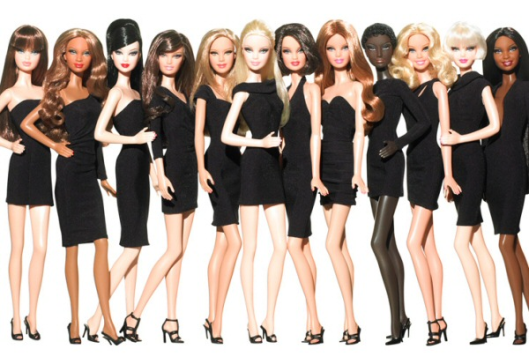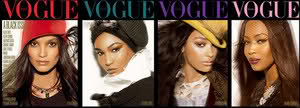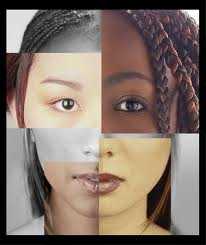In April of 2008, the same year that the Vogue Italia-All Black Issue [See below post] was released, but a few months ahead, Alex Alvarez, an associate editor wrote an article titled Model Minority: How Women’s Magazines Whitewash Different Ethnicities. Throughout the article, Alvarez basically breaks down the racial stereotype for women of different ethnicities, and talks about how each ethnic minority is portrayed in its own stereotypical way.
On each racial background, the writer gives a ‘brief overview’ which consists of a short paragraph depicting how this particular race is represented in most fashion magazines, an ‘Ideal’ which is a woman from that ethnic background whom the fashion magazine show frequently as the ‘ideal’ woman e.g. Jennifer Lopez- the ideal Latina, a few quick points on how their skin, hair and body features should look like and then finally an ‘How magazines have fucked up’ paragraph which talks about how magazines feed this idea of the ideal woman and the way she should look to people of that ethnic background and how it’s wrong.
During the section about black women, the writer makes, what I thought, was a very interesting the point; ‘Brief Overview: While black women can come in a variety of shapes and complexions, those who are most often represented in mainstream American magazines are often, for lack of a better, equally descriptive phrase, “white-washed” in appearance. Features that are seen of characterized of black people, like curlier hair textures, wider noses and fuller lips, are often downplayed in American magazines, conforming to a white standard of beauty. While black women are “allowed” to be more overtly sexual than those who are white, many “high fashion” black models are quite thin and thus their backsides are smaller and the object of less focus than black women represented in other areas of mainstream entertainment.’ I also believe that the idea of beauty in different races within the media differs depending on what type of media you’re looking at, stick thin black and Hispanic women on the runways of Paris versus the curvaceous black and Hispanic women seen in several music videos nowadays. As some magazines may portray Hispanic and Black Women as curvy, and exotic looking on their pages, in reality looking at most successful high fashion editorial models within the same industry and from the same racial background they are incredibly thin and even though they’re facial features and skin tones may represent those of that background, their bodies do not, yet they are still considered beautiful. In a similar way, mainstream magazines have black women on the covers who don’t necessarily have facial features which are seen as characteristics of black people, yet they have the stereotypical curvy body of a black woman, and are again considered beautiful. Therefore I think that each sector of the industry simply attempts to cater to its audience; the fashion industry by introducing models with exotic different features and diverse skin tones whereas as still conforming to the model body type and the mainstream magazine media by doing the same thing yet trying to still keep it relatable to a large percentage of the population and its audience with regards to the facial features.
One thing that particularly caught my eye within this article was that, the writer wasn’t limiting her stereotypes to the usual black versus white, however she was taking the time to regard the other races that are fairly under-represented within the fashion industry and quite frankly mostly forgotten about. ‘Brief Overview: Asian women hold a curious place in the beauty stratum. Often, what is perceived as their “natural” physical traits are encouraged and often emulated by White women trying to achieve a certain standard of beauty? The idea of a natural physical ideal is a harmful one, because those who do not possess such traits are ignored or considered somehow inferior, physically. The Asian ideal, as perceived by American fashion magazines and elsewhere, revolves around the idea that one must be petite, slim, fair and delicate. Doll-like would be the best way to describe this ideal, both in terms of physical appearance and attitude.’ To me the point about Asian women was the one that made me think the most, I thought this one was probably the truest one in the bunch, because with the previous two we could almost argue that not all black/Hispanic women are portrayed like this in magazines, however with the Asian ‘brief overview’ I found myself struggling to think of a time that I had opened a magazine and seen an Asian woman, which is rare, who isn’t portrayed in this stereotypical way. After reading this I noticed that almost Asian women in fashion magazines are portrayed as this youthful doll-like image, which makes their features seem even more striking and incredible yet almost surreal in a sense. I also noticed that all the Asian models seemed to have incredibly pale skin and petite figures, yet in reality, with the Asian people I know, they seem to have a slightly more tanned skin tone and as within any race come in array of different body shapes as the writer also expresses ‘Some Asian girls are chubby. Really! Some are muscular, some are tall, some are dark, some are doughy, and some are boney and awkward.’ The ‘brief overview’ made me wonder whether this is just the western idea of Asian beauty, or if Asian women themselves also strive to look this way?
The most surprising racial stereotype however was the one about white women- ‘Brief Overview: The gold standard of white beauty is a woman who is thought of as being the least “ethnic” and most “neutral” as possible. Fair skin, fair hair and thin, often lacking in curves that would be considered vulgar or distasteful (or exotic?) the stereotype of corn-fed Midwestern girls or sun-kissed, muscular athletic girls are eschewed for fair, tall, boney girls – often with what is described as a “boyish” figure, one without the tell-tale markers of womanhood – hips, ass. Personality. Irish-Americans, for example, who are today almost synonymous with the concept of what it means to be white (fevered dancing without the use of hips or shoulders, the consumption of potatoes), were very much “the other” for a very, very long time in America. Jewish and Italian Americans were also not always considered white folks here in the old U.S. of A. This isn’t mentioned to encourage anyone to wait whiteness out, it’s meant to highlight the fact that whiteness is a culturally manufactured concept and is only given meaning by a certain segment of society in a certain slice of history.’ I feel like we as a generation are so used to seeing white women dominate the pages of our high fashion magazines that we don’t seem to notice that it’s always the same type of pretty white blonde girl next door we see. The idea of the ‘perfect white women’ seems so bizarre to us, yet this article actually educated me a lot about opening my eyes and realising that every race has its own underlying pressures from people within their own race and people outside their own race to look a certain way and conform to a particular stereotype.
I personally feel like despite this being a good article the writer has failed to realize the fact that women’s magazines now feature all types of people, from actresses to singers and not just models, and therefore now the whole magazine industry is a business a way for people to promote themselves through being on the cover of a big name mag, and so we can’t just point the finger in the direction of the editors and say they’re the racist ones, and they’re the ones creating these stereotypes, I think the problem lies a lot deeper than that.
All in all although I didn’t agree with all the points the writer made, and the way in which she made them, it made me question my whole outlook onto the whole ‘Racism within the fashion Industry’ debate, are the fashion industry still racist if they prefer a pretty tanned blonde girl to a pretty pale-skinned ginger girl? Or if they put a stick thin light-skinned black woman on the cover of their magazine as opposed to a dark skinned curvy woman? I think the real question is are they simply giving us what we really want to see?
Source:[Read the full article here on racialicious.com [http://www.racialicious.com/2008/04/10/model-minority-how-womens-magazines-whitewash-different-ethnicities/]] April 10th 2008.





